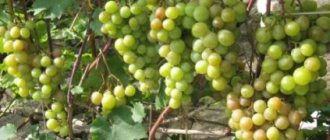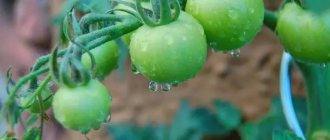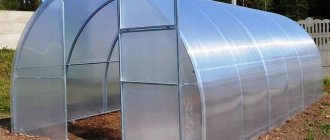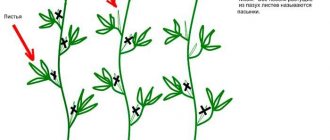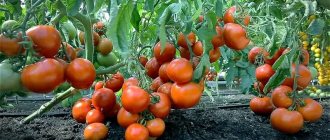Sheltering grapes for the winter is an important agrotechnical measure. Not many novice gardeners know when and how to properly protect a plant from severe frosts. Grapes are a southern, heat-loving plant, so it is necessary to prepare the vine for winter in the proper way. But, among other things, it is necessary to prevent the grapes from drying out, otherwise the owners risk being left not only without a tasty harvest, but also completely without grape bushes. In this article we will tell you how to properly cover grapes for the winter in a polycarbonate greenhouse. To help beginning gardeners - a detailed video.
When to cover grapes?
Severe frosts, which are typical for most of Russia, can destroy not only annual seedlings, but also adult bushes. Without shelter, grapes can tolerate frost down to -15 degrees. A further drop in temperature leads to the death of grape eyes. First of all, annual seedlings are susceptible to this. To prevent such an unfortunate development of events, the gardener must take care of shelter for the plant with the onset of the first cold weather. But shelter alone is not enough; this event still needs to be carried out correctly.
The root system of grapes is very sensitive to low temperatures
Attention! The aboveground parts of the grapes are able to survive low temperatures, but the root system of the plant cannot boast of such frost resistance. Even a slight frost around -5 degrees can damage the fibrous part of the root system, which will ultimately lead to the death of the grapes. If the above-ground part can still be restored in case of frostbite, then in the second case this is impossible.
Of course, you first need to know the temperature regime of the region. If in your area frosts never exceed -16 degrees, then there is no need to worry too much. Frost-resistant varieties can survive harsher frosts. If it is almost impossible to predict the temperature regime of the region, then the best thing to do is to protect the plant from freezing and cover all the grape bushes.
Keep an eye on this.
If plants do not receive enough moisture, they are often affected by powdery mildew. In closed ground, grapes require a lot of water, especially potted ones.
The berries turn out small and do not fill out if too many clusters are left on the young vine. Limit yourself to two bunches the first year and about five the second. Thin the berries in the bunch to help them fill out better.
Provide grapes growing in a container with such an umbrella support, and the vine will grow and give you berries every year.
The most common methods of shelter
At the first stage, the grape bushes themselves are prepared for wintering, and after that agrotechnical measures are taken to cover the plant. Experienced gardeners recommend using the three most common methods:
- full cover;
- hilling;
- semi-shelter of bushes
It is necessary to cover grapes with natural, “breathable” fabrics
The preparation of grape bushes is as follows:
- First of all, all the bushes are removed from the trellis.
- The vines are being pruned.
- All plant debris is cut off.
- Grape bushes are treated with iron sulfate.
- Abundant watering is carried out.
- If the integrity of the bushes is periodically threatened by rodents, then it is best to place bait under the vine to neutralize the pests
To properly cover grapes, you need to familiarize yourself in detail with the most reliable method.
Things to remember
In order for the grapes to successfully survive the winter in the greenhouse, you need to first prepare the fruit vine. A strong plant with an excellent supply of nutrients will easily survive the vagaries of nature. Therefore, be sure to worry about regular feeding.
It is necessary to harvest the crop in advance for the vine to ripen.
Remember: the longer the fruits hang on the branches, the less time the bush has to reserve useful elements for future use.
It is recommended to apply potassium fertilizers in the winter, which accelerate the ripening of young shoots. Nitrogen-containing substances activate foliage growth, which slows down the preparation of the bush for wintering. After harvesting, the plants are fed:
- potassium magnesia;
- wood ash;
- potassium sulfate.
To ensure that substances are absorbed faster, experienced gardeners spray fertilizer on the leaves. The concentration of the drug is reduced by half, but the frequency of treatments is increased to 1 time every 7 days.
Remember: the procedure is carried out in the morning or evening so that the chemicals in the sun do not burn the foliage.
Yield rationing also ensures rapid ripening of young shoots. The optimal number of bunches will not deplete the bush and will not make the vine too “overfed”, which also negatively affects the survival of the plant in winter. A mature branch is straw-brown in color and makes a slight cracking sound when bent, but does not break.
Preparing the vine - pre-pruning
Autumn pruning is not a whim of gardeners, but a necessary preventive procedure. Sick and immature vines do not survive wintering conditions, so they become a breeding ground for diseases and infections. After the plant has shed its leaves, the winegrowers begin a thorough inspection and rejection of the branches.
Professionals recommend carrying out the operation after the first frost, as early action will weaken the fruit vine.
Remember: you cannot prune or pick greens immediately after harvesting. The plant has spent energy and nutrients on the fruits, so it needs time to replenish its reserves for the winter.
Preventive treatments with fungicides will protect grapes from pathogenic fungi and infections. Even if your greenhouse has not been affected by mildew or oidium this season, spraying it with Bordeaux mixture or copper sulfate for the winter should not be skipped.
Rodents and insects will also not allow the fruit vine to overwinter peacefully. Therefore, it is recommended to worry about preventive treatments in advance.
Circular laying of vines saves space
“If the grapes were sick, then after harvesting, when there is no longer any danger of eating fruits treated with fungicides, it’s time to treat with some systemic fungicide in a therapeutic (one-and-a-half or double) concentration. This will significantly suppress the pathogen and enable the vines to ripen better and approach winter relatively healthy.”
Wintering in a greenhouse requires regular ventilation of the premises. Condensation is deadly to grapes.
The higher the air humidity, the more dangerous the environment for the crop. Why is this happening? When at rest, the plant does not absorb water, so any moisture leads to rot and disease. Sharp frosts will kill the buds and roots.
Read also: How to treat an open wound on a finger
We figured out how to cover grapes for the winter in a greenhouse. Using our recommendations, you will preserve the capricious fruit vine under unfavorable climatic conditions and protect it from fungi and diseases.
Sheltering grapes for the winter is an important agrotechnical measure. Not many novice gardeners know when and how to properly protect a plant from severe frosts. Grapes are a southern, heat-loving plant, so it is necessary to prepare the vine for winter in the proper way. But, among other things, it is necessary to prevent the grapes from drying out, otherwise the owners risk being left not only without a tasty harvest, but also completely without grape bushes. In this article we will tell you how to properly cover grapes for the winter in a polycarbonate greenhouse. To help beginning gardeners - a detailed video.
The most reliable way to cover grapes
The first and most important condition that must be observed with this method is that the grapes must be covered only with material made from natural fabric. At the initial stage, the gardener must remove each bush from the trellis and wait for the leaves to naturally fall off. After which the bush is formed to the required size by pruning. You can use anything as a covering material, even unnecessary old things. But at the same time strictly observe the main rule.
Complete cover of grapevines in a greenhouse
The grapes, covered with natural fabric, are covered with film and pressed to the ground using special brackets, after which they are covered with earth. Depending on the frost, either a small layer or an impressive layer of up to 30 cm is poured.
Attention! Resistant and frost-resistant varieties are often covered simply with slate.
Complete shelter is the method that will one hundred percent protect the grapes from severe frosts. If expectations about severe frosts are not met, then ventilation must be installed in the structure to prevent the grapes from steaming. If there were expectations of a warm winter, but ultimately severe frosts came, then emergency sheltering is carried out - the grapes are pressed to the ground and covered with earth.
Before covering the grapevines, they are treated with copper sulfate
Implementation of watering
Greenhouse grapes require careful watering.
In this case, you will have to observe some features:
- the first watering is carried out immediately after planting;
- a week after planting it is also worth saturating the soil with water;
- In summer, it is customary to water the vines once a week;
- If the berries are ripe, they need to be watered rarely, otherwise the fruits will crack.
There is another important point: do not water the plant in the evening! Otherwise, the fruits will become unusable.
Sheltering grapes in a greenhouse for the winter
An unheated polycarbonate greenhouse for grapes will also be a kind of protection, but severe frosts can damage the plant. The main problem that a gardener faces when placing bushes in a greenhouse is dense placement in small quantities. During the frostiest time in the greenhouse, experienced winegrowers cover the bushes with simple plastic film, and with the onset of warmth they simply throw it off.
Growing in a greenhouse has a number of advantages, but the main problem that every owner faces is not freezing, but damping off. Even capricious grape varieties feel comfortable under the protective layer of honeycomb carbonate. Grapes often dry out due to the fact that under cover the plant is exposed to high humidity; frost crust has a particularly detrimental effect on the vine. The best solution is to install special end ventilation, which could be opened and closed if necessary. For these purposes, dry leaves are most often used, which are placed in the voids between the covered grapes and the soil.
In a polycarbonate greenhouse, it is not recommended to heavily cover the vines. because they will start to rot away
Cozy at home
Checked!
It is useful to dust the ground with wood ash, and add a fresh layer of dry sand to the paths several times during the summer. As soon as there is the slightest hint of a greenhouse effect, I increase ventilation or sprinkle well-decomposed dry compost (horse manure with sawdust) aged many years over the entire row of growing grapes. People sometimes ask me: why is there no moss visible in my greenhouse? But it will never happen if you loosen the soil after and between waterings. In the greenhouse, the grapes are reliably protected from the vicissitudes of the climate, and they do not have problems associated with frosts, rains, etc. In addition, the plants in the “house” are much warmer than those growing in the open air, which affects the quality and timing of the ripening of the crop . In warm and hot weather, both tall, wide doors are fully open not only during the day, but also at night, so there is no overheating. In bad weather (rain with strong gusts of wind, chilly weather, etc.), only two wide transoms remain open, and the doors are tightly closed. I tie up the shoots of greenhouse grapes so that they do not shade each other. The height of the greenhouse is two meters, so it is possible to grow even vigorous varieties.
The “greenhouse” has greatly simplified caring for the vineyard, and being in it in any weather is a pleasure. By closing it from the inside, you can work comfortably on rainy or cold days. There is enough space left between the edging of the “bed” and the wall so that you can move freely there - with a pruner in your hands (for removing stepsons and leaves, trimming shoots, etc.), with a hoe (for loosening and fighting weeds) or a bowl (when picking berries). The greenhouse allows for extended harvesting, regardless of the weather. There is no need to rush due to early autumn frosts. In addition, all the berries go to people, not birds, and without any straining of nets.
Grapes and arcs inside the greenhouse. Photo: From personal archive / Maria Anashina
Mistakes to Avoid While Covering
Beginning gardeners are more susceptible to making plant-damaging mistakes. To avoid unpleasant consequences, you must consider the following:
- do not put too much soil on the film;
- do not use soil that was in close proximity to the grape bushes for covering;
- carefully consider ventilation for the plant, which will save you from many troubles.
Proper sheltering of grapes in a greenhouse will protect the plant from freezing and drying out, and ultimately allow the owners to enjoy a tasty harvest.
reference Information
The main advantage of growing fruit vines in a greenhouse is the ability to obtain a bountiful harvest in unfavorable weather conditions. The countries of the Mediterranean and the Caucasus, with their warm, mild climate, are considered the homeland of grapes. Plants are not exposed to scorching heat or aggressive cold, so cultivation will not be a problem.
In domestic conditions, growing grapes in a greenhouse is expensive only at the initial stage, when you need to immediately invest in equipment for the premises.
Grapes in a greenhouse give excellent yields and are protected from diseases
Active development of the crop and high yields are ensured even by the most capricious southern varieties. Protected soil will allow you to cultivate fruit vines even in rainy, cool summers.
Read also: How to insulate windows for the winter
Recently, greenhouses have been used not only by large farms, but also by ordinary gardeners. With a reasonable approach, the design can be equipped with a drip irrigation system, which will create a natural habitat for the crop. Ventilating the room and regular treatments will protect the grapes from fungi and insects.
Reeds for shelter must be prepared in advance


